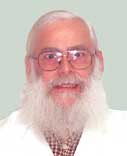Mark Skalsey
Mark Skalsey, associate research scientist and lecturer in physics at LSA, died Feb. 23. He was 58.

Skalsey was born in Detroit and graduated from Cass Technical High School. He earned a bachelor’s degree in physics in 1971 from U-M. He earned a master’s degree in nuclear physics in 1974 from the University of Manitoba then returned to Michigan to begin his doctoral studies in physics.
After a brief period at the U-M cyclotron, in 1976 he began to work with professor Arthur Rich in his atomic physics labs. Skalsey’s expertise in nuclear physics blended well with Rich’s atomic research with antimatter (positrons), in particular studies of the spin polarization of positrons produced in nuclear beta decay.
Skalsey’s doctoral thesis in 1982 searched for variations in positron polarization from different nuclei due to hypothesized variations in the fundamental theory of weak interaction beta decay. He continued this kind of highly innovative research as a post-doctoral researcher with Rich, doing collaborative work at the Princeton cyclotron with the University of Toronto. Skalsey was promoted to research scientist in the late 1986 and continued his unique blend of nuclear/atomic physics becoming a mainstay of the so-called Leptons Interactions Group after Rich’s death in 1990.
Skalsey’s research had distinctive characteristics: absolutely original, searching for cracks in fundamental theories, marvelously low-budget on existing equipment in the group and always publishable, says physics professor David Gidley. His experiments also always included students, both undergraduate and graduate. He promoted his students, four of whom won awards for their undergraduate thesis work, preferring a more behind-the-scenes role for himself. Skalsey cultivated a gruff exterior to hide the teddy-bear inside, and his students universally developed a friendship and admiration for their mentor, Gidley says. He published more than 50 physics articles, spoke at numerous conferences and taught introductory physics for many years.
Skalsey’s most recent research involved the world’s highest rate positron beam at the North Carolina State University nuclear reactor. Throughout the 1990s he watched two European nuclear reactors generate positron beams through the pair production process by high-energy gamma rays produced in the reactor’s core. He built a successful prototype positron beam in the Michigan Leptons group with the goal of building an intense beam in the Ford nuclear reactor, part of the Phoenix Memorial Laboratory dedicated to the peaceful use of nuclear energy.
The positron beams have a variety of uses from testing fundamental theories of how electrons, positrons (the antiparticles of electrons), and photons interact to studying materials in materials science.
“Mark Skalsey’s interests were almost always in the first area of using positrons to test fundamental theories,” Gidley says. “He liked to use antimatter as an annihilation tool and look for exotic decay modes that should be forbidden by standard theory — to see an exotic decay meant the theory was not fully correct. Hence we liked to joke that he typically measured absolutely nothing at all — he was the best at measuring ‘zero.’
“We respected his work because these ‘null experiments’ are the hardest experiments to do right and believably.”
After the University’s decommissioning of the Ford reactor, Skalsey led the group’s collaborative effort to build a prototype beam that operated so well in the core of the NCSU reactor in Raleigh that the National Science Foundation funded a three-year, $1 million grant to build the full-scale beam.
The group’s collaborators at NCSU announced in December the achievement of the world’s highest rate positron beam — testimony in part to Skalsey’s vision and scientific perseverance.
“His broad view of the intermingling of nuclear and atomic physics will be missed in the University of Michigan’s Physics Department,” Gidley says.

